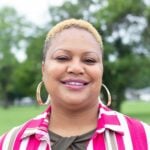As COVID-19 tightened its stranglehold on America, one thing became clear with the release of data: African Americans are and will be hit hardest — physically, mentally and financially.
Working for a publication that focuses on the Black residents of Indianapolis, it’s our job to continually illuminate this disparity so it might someday change. But, it is heartbreaking; it is depressing; it is maddening to think and write about the disparities that ravage our community day after day, week after week.
However, I’m grateful COVID-19 is finally exposing just how deep those disparities go. What COVID-19 has done — and done so well — is connect the dots of race and disparity in all aspects of life for Black people. We often speak about intersectionality when it comes to race, sexuality and gender identification, but we need to expand the conversation to include socioeconomic status, health and education and probably more.
We know if you’re Black, you’re at a higher risk for complications from COVID-19 because of underlying conditions. Well, you’re likely to have underlying health conditions because of a poor diet and lack of health insurance or being underinsured (health care disparity).
Your insurance is determined by where you work. If you work in a low-wage job, you’re likely to have insurance that may cost more than your check so you go without it. Or, you have insurance “just in case” but it covers the bare minimum and you don’t want to use it for fear of expensive copays and high deductibles.
Many low-wage workers continue to be on the front lines, still going to work every day since the outbreak of this pandemic (income-gap disparity). Those low-wage workers whose jobs did shut down aren’t working from home because that’s not the nature of their job, so they’re at home without pay, waiting for unemployment benefits and a stimulus check. And if they could actually work from home, they couldn’t because they don’t have internet access (digital divide). And guess who else can’t work from home. Their children (education gap). The lack of internet access means their children simply can’t wake up, sit in front of their laptop and e-learn. Is there even a computer to do this? Many families who are working hard just to make ends meet can’t afford a computer. Previously, they went to the library to use the computer lab.
There’s also the issue of transportation and where one lives. Many classified as the working poor take public transportation because they can’t afford a car (socioeconomic disparity). A large number of Indianapolis’ Black residents live in a food desert, making them susceptible to poor health.
And while social distancing sounds good, let’s face it, there are some among us who can’t do this because their home isn’t big enough, there are too many people in it, or they take care of a family member.
It’s not a far-fetched scenario to think someone could be a grocery store worker who takes the bus to work every day then comes home to care for an unwell parent. The level of potential exposure and health risks in this one situation is off the charts, but this is the reality for a large swath of our community.
Some may say my ramblings are nothing more than that — hyperbolic ramblings — but this is reality for our community. This is why COVID-19 is so scary for our community. I know there are some among us who believe COVID-19 is doing exactly what it’s supposed to do — ravage the Black community. However, this is too macabre for me. There would be no point in fighting if this were the case, and I believe in fighting systemic racism at every opportunity. COVID-19 gives us a clear picture of what we’re up against — and it’s a lot, but that’s never stopped us before — and it won’t now.





